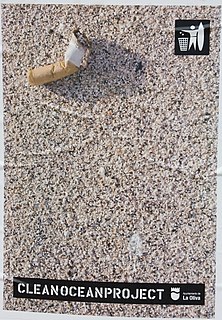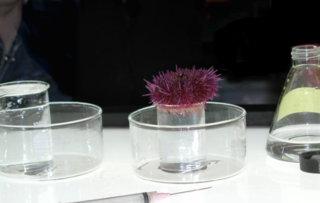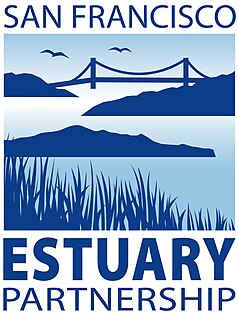
A biosurvey, or biological survey, is a scientific study of organisms to assess the condition of an ecological resource, such as a water body.

A biosurvey, or biological survey, is a scientific study of organisms to assess the condition of an ecological resource, such as a water body.
Biosurveys are used by government agencies responsible for management of public lands, environmental planning and/or environmental regulation to assess ecological resources, such as rivers, streams, lakes and wetlands. They involve collection and analysis of animal and/or plant samples which serve as bioindicators. The studies may be conducted by professional scientists or volunteer organizations. They are conducted according to published procedures to ensure consistency in data collection and analysis, and to compare findings to established metrics.
Biosurveys typically use metrics such as species composition and richness (e.g. number of species, extent of pollution-tolerant species), and ecological factors (number of individuals, proportion of predators, presence of disease). Biosurveys may identify pollution problems that are difficult or expensive to detect using chemical testing procedures. [1]
A biosurvey may be used to generate an index of biological integrity (IBI), a scoring system for an ecological resource. [1]
Protocols for conducting biosurveys of water resources have been published by state government agencies [2] and the U.S. Environmental Protection Agency (EPA). [3] Agencies use these protocols to implement the Clean Water Act. Similar protocols have been published by volunteer organizations. [4]

Environmental law is a collective term encompassing aspects of the law that provide protection to the environment. A related but distinct set of regulatory regimes, now strongly influenced by environmental legal principles, focus on the management of specific natural resources, such as forests, minerals, or fisheries. Other areas, such as environmental impact assessment, may not fit neatly into either category, but are nonetheless important components of environmental law.
This is an index of conservation topics. It is an alphabetical index of articles relating to conservation biology and conservation of the natural environment.

Water quality refers to the chemical, physical, and biological characteristics of water based on the standards of its usage. It is most frequently used by reference to a set of standards against which compliance, generally achieved through treatment of the water, can be assessed. The most common standards used to monitor and assess water quality convey the health of ecosystems, safety of human contact, extend of water pollution and condition of drinking water. Water quality has a significant impact on water supply and oftentimes determines supply options.

Environmental protection is the practice of protecting the natural environment by individuals, organizations and governments. Its objectives are to conserve natural resources and the existing natural environment and, where possible, to repair damage and reverse trends.

The Clean Water Act (CWA) is the primary federal law in the United States governing water pollution. Its objective is to restore and maintain the chemical, physical, and biological integrity of the nation's waters; recognizing the responsibilities of the states in addressing pollution and providing assistance to states to do so, including funding for publicly owned treatment works for the improvement of wastewater treatment; and maintaining the integrity of wetlands.
Freshwater ecosystems are a subset of Earth's aquatic ecosystems. They include lakes, ponds, rivers, streams, springs, bogs, and wetlands. They can be contrasted with marine ecosystems, which have a larger salt content. Freshwater habitats can be classified by different factors, including temperature, light penetration, nutrients, and vegetation. There are three basic types of freshwater ecosystems: Lentic, lotic and wetlands. Freshwater ecosystems contain 41% of the world's known fish species.

Aquatic toxicology is the study of the effects of manufactured chemicals and other anthropogenic and natural materials and activities on aquatic organisms at various levels of organization, from subcellular through individual organisms to communities and ecosystems. Aquatic toxicology is a multidisciplinary field which integrates toxicology, aquatic ecology and aquatic chemistry.

A bioindicator is any species or group of species whose function, population, or status can reveal the qualitative status of the environment. The most common indicator species are animals. For example, copepods and other small water crustaceans that are present in many water bodies can be monitored for changes that may indicate a problem within their ecosystem. Bioindicators can tell us about the cumulative effects of different pollutants in the ecosystem and about how long a problem may have been present, which physical and chemical testing cannot.
RIVPACS is an aquatic biomonitoring system for assessing water quality in freshwater rivers in the United Kingdom. It is based on the macroinvertebrate species found at the study site during sampling. Some of these species are tolerant to pollution, low dissolved oxygen, and other stressors, but others are sensitive; organisms vary in their tolerances. Therefore, different species will usually be found, in different proportions, at different river sites of varying quality. Some organisms are especially good indicator species. The species found at the reference sites collectively make up the species assemblage for that site and are the basis for a statistical comparison between reference sites and non-reference sites. The comparison between the expected species and the observed species can then be used to estimate this aspect of the ecological health of a river.

Aquatic biomonitoring is the science of inferring the ecological condition of rivers, lakes, streams, and wetlands by examining the organisms that live there. While aquatic biomonitoring is the most common form of biomonitoring, any ecosystem can be studied in this manner.
Environmental indicators are simple measures that tell us what is happening in the environment. Since the environment is very complex, indicators provide a more practical and economical way to track the state of the environment than if we attempted to record every possible variable in the environment. For example, concentrations of ozone depleting substances (ODS) in the atmosphere, tracked over time, is a good indicator with respect to the environmental issue of stratospheric ozone depletion.

The DSSAM Model is a computer simulation developed for the Truckee River to analyze water quality impacts from land use and wastewater management decisions in the Truckee River Basin. This area includes the cities of Reno and Sparks, Nevada as well as the Lake Tahoe Basin. The model is historically and alternatively called the Earth Metrics Truckee River Model. Since original development in 1984-1986 under contract to the U.S. Environmental Protection Agency (EPA), the model has been refined and successive versions have been dubbed DSSAM II and DSSAM III. This hydrology transport model is based upon a pollutant loading metric called Total maximum daily load (TMDL). The success of this flagship model contributed to the Agency's broadened commitment to the use of the underlying TMDL protocol in its national policy for management of most river systems in the United States.
Biological integrity is associated with how "pristine" an environment is and its function relative to the potential or original state of an ecosystem before human alterations were imposed. Biological integrity is built on the assumption that a decline in the values of an ecosystem's functions are primarily caused by human activity or alterations. The more an environment and its original processes are altered, the less biological integrity it holds for the community as a whole. If these processes were to change over time naturally, without human influence, the integrity of the ecosystem would remain intact. The integrity of the ecosystem relies heavily on the processes that occur within it because those determine what organisms can inhabit an area and the complexities of their interactions. Most of the applications of the notion of biological integrity have addressed aquatic environments, but there have been efforts to apply the concept to terrestrial environments. Determining the pristine condition of the ecosystem is in theory scientifically derived, but deciding which of the many possible states or conditions of an ecosystem is the appropriate or desirable goal is a political or policy decision and is typically the focus of policy and political disagreements. Ecosystem health is a related concept but differs from biological integrity in that the "desired condition" of the ecosystem or environment is explicitly based on the values or priorities of society.
The biological monitoring working party (BMWP) is a procedure for measuring water quality using families of macroinvertebrates as biological indicators.
An index of biological integrity (IBI), also called an index of biotic integrity, is a scientific tool typically used to identify and classify water pollution problems, although there have been some efforts to apply the idea to terrestrial environments. An IBI associates anthropogenic influences on a water body with biological activity in the water body, and is formulated using data developed from biosurveys. Biological integrity is associated with how "pristine" an environment is and its function relative to the potential or original state of an ecosystem before human alterations were imposed. Biological integrity is built on the assumption that a decline in the values of an ecosystem's functions are primarily caused by human activity or alterations. The more an environment and its original processes are altered, then by definition, the less biological integrity it holds for the community as a whole. If these processes were to change over time naturally, without human influence, the integrity of the ecosystem would remain intact. Similar to the concept of ecosystem health, the integrity of the ecosystem relies heavily on the processes that occur within it because those determine which organisms can inhabit an area and the complexities of their interactions. Deciding which of the many possible states or conditions of an ecosystem is appropriate or desirable is a political or policy decision.
Traditional ecological knowledge (TEK) describes indigenous and other traditional knowledge of local resources. As a field of study in Northern American anthropology, TEK refers to "a cumulative body of knowledge, belief, and practice, evolving by accumulation of TEK and handed down through generations through traditional songs, stories and beliefs. It is concerned with the relationship of living beings with their traditional groups and with their environment." It is important to note that indigenous knowledge is not a universal concept among various societies, but is referred to a system of knowledge traditions or practices that are heavily dependent on "place". Such knowledge is used in natural resource management as a substitute for baseline environmental data in cases where there is little recorded scientific data, or may complement Western scientific methods of ecological management.

The natural environment, commonly referred to simply as the environment, includes all living and non-living things occurring naturally on Earth.

The United States Environmental Protection Agency (EPA) was established in July 1970 when the White House and the United States Congress came together due to the public's demand for cleaner natural resources. The purpose of the EPA is to repair the damage done to the environment and to set up new criteria to allow Americans to make a clean environment a reality. The ultimate goal of the EPA is to protect human health and the environment.

The San Francisco Estuary Partnership (Partnership) is one of the 28 National Estuary Programs created in the 1987 Amendments to the Clean Water Act. The Partnership is a non-regulatory federal-state-local collaboration working to restore water quality and manage the natural resources of the San Francisco Bay-Sacramento–San Joaquin River Delta estuary. The Partnership works with over 100 municipalities, non-profits, governmental agencies, and businesses and helps develop, find funding for, and implement over 40 projects and programs aimed at improving the health of the estuary. The partnership either directly implements these projects, or administers and manages grants, holds educational workshops and highlights project results. The Partnership is also the official representative for the San Francisco Bay region to the Most Beautiful Bays in the World.
In aquatic toxicology, the sediment quality triad (SQT) approach has been used as an assessment tool to evaluate the extent of sediment degradation resulting from contaminants released due to human activity present in aquatic environments. This evaluation focuses on three main components: 1.) sediment chemistry, 2.) sediment toxicity tests using aquatic organisms, and 3.) the field effects on the benthic organisms. Often used in risk assessment, the combination of three lines of evidence can lead to a comprehensive understanding of the possible effects to the aquatic community. Although the SQT approach does not provide a cause-and-effect relationship linking concentrations of individual chemicals to adverse biological effects, it does provide an assessment of sediment quality commonly used to explain sediment characteristics quantitatively. The information provided by each portion of the SQT is unique and complementary, and the combination of these portions is necessary because no single characteristic provides comprehensive information regarding a specific site
| Wikimedia Commons has media related to Biological surveys . |